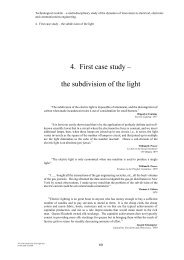Valuation Techniques for Social Cost-Benefit Analysis: - HM Treasury
Valuation Techniques for Social Cost-Benefit Analysis: - HM Treasury
Valuation Techniques for Social Cost-Benefit Analysis: - HM Treasury
Create successful ePaper yourself
Turn your PDF publications into a flip-book with our unique Google optimized e-Paper software.
24<br />
learning and experience Bateman et al. (2006) instead recommend a double-bound <strong>for</strong>mat<br />
where participants have the opportunity to ‗discover‘ their preferences in the survey.<br />
However, the neurological evidence on the effects of anchoring (Plassman et al., 2008) would<br />
suggest that prices should not be mentioned in any <strong>for</strong>mat during a contingent valuation survey<br />
and there<strong>for</strong>e that the open-ended elicitation <strong>for</strong>mat would be most suitable. Under this <strong>for</strong>mat,<br />
participants are simply asked to state their maximum WTP or minimum WTA, with no mention<br />
of a starting price (which would create an anchor). At the same time, however, this <strong>for</strong>mat takes<br />
the respondents in contingent valuation further away from the type of market institutions with<br />
which they are familiar when deciding whether to buy a good.<br />
In addition, it is not clear how applicable these results are <strong>for</strong> the stated and revealed preference<br />
methods because opportunities <strong>for</strong> learning are often minimal. It is hard to provide repetitive<br />
experience <strong>for</strong> many of the public goods assessed in stated preference (Braga and Starmer,<br />
2005) and revealed preference often relies on markets where transactions are infrequent (eg,<br />
housing market) so that few chances <strong>for</strong> learning exist at the individual level (Genesove and<br />
Mayer (2001). To counteract this Bateman et al. (2009) have recently used virtual reality<br />
simulators to communicate environmental changes to survey respondents. Some contingent<br />
valuation surveys also now employ a workshop <strong>for</strong>mat whereby people discuss the valuation<br />
issues with others and they can seek further in<strong>for</strong>mation from moderators and experts (Hanley<br />
and Shrogen, 2002).<br />
Alternatively, Gregory et al. (1993), propose a deliberative CV mechanism (multi-attribute utility<br />
analysis) in which a group of stakeholders, that includes the affected citizenry and technical<br />
experts, assesses the merits of the good under consideration and determines which attributes<br />
have the greatest impact on utility and an agreed conversion scale to monetise the ‗utils‘ 10 . They<br />
claim that<br />
―designers of a CV study should function not as archaeologists, carefully uncovering<br />
what is there, but as architects, working to build a defensible expression of value‖<br />
Gregory et al. (1993).<br />
There is some recent work on combining stated and revealed preference data. This allows stated<br />
preference data to be checked against actual behaviour whilst also extending the range of<br />
goods estimable <strong>for</strong> revealed preference methods. Stated preference data can also help in<br />
isolating causal effects in hedonic market approaches, especially in trip cost methods <strong>for</strong><br />
recreational sites (see Accent, 2010 and Whitehead et al., 2008 <strong>for</strong> a full discussion).<br />
4.2.2 Whether life satisfaction is a good measure of utility<br />
The subjective well-being approach assesses the impact of non-market goods on people‘s life<br />
satisfaction as reported in surveys such as the ONS‘s Integrated Household Survey. The approach<br />
does not rely on the rationality axioms holding and there<strong>for</strong>e avoids many of the problems<br />
associated with the preference-based approaches that were outlined in section 4.2.1. The<br />
approach does, however, rely on stated life satisfaction being an accurate measure of welfare or<br />
utility. It is possible to challenge whether this is the case.<br />
Life satisfaction can be seen as being made up of a balance of affect (positive and negative<br />
emotions and feelings) together with a cognitive assessment of how well one‘s life measures up<br />
to aspirations and goals (Diener, 1984; Kahneman and Krueger, 2006). A life satisfaction<br />
response will incorporate to some extent a retrospective judgement of one‘s life together with<br />
10 Multi-attribute utility analysis is a <strong>for</strong>m of Multi-Criteria <strong>Analysis</strong>. For full details see Department <strong>for</strong> Communities and Local Government (2009)<br />
Multi-criteria analysis: a manual.





![AIRTO [Professor Dr Brian Blunden] - HM Treasury](https://img.yumpu.com/15492848/1/184x260/airto-professor-dr-brian-blunden-hm-treasury.jpg?quality=85)










